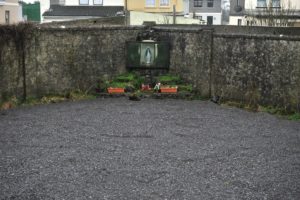Will the Tuam Babies Scandal Ignite an Investigation into Church-State Relations in Ireland?
 The site at Bon Secours Mother and Baby Home in Tuam, County Galway.
The site at Bon Secours Mother and Baby Home in Tuam, County Galway. In 2012 amateur historian Catherine Corless began investigating the abandoned Bon Secours Mother and Baby Home in Tuam, County Galway, Ireland. Disconcerted by the lack of media attention given to her finding that 796 babies had died there in the span of thirty-six years, Corless began the painstaking journey to discover the truth of what happened under the eyes of the Bon Secours nuns. Her work led to the creation of the Commission of Investigation into Mother and Baby Homes, which has come under increased scrutiny in the past weeks with the discovery of what’s been reported as “significant quantities of human remains” buried in septic tanks on the grounds of the home for unwed mothers and their children operated by Catholic nuns from 1922 to 1961. Despite the fact that the Irish government has held the outrageously high death registers of the home since 2011, the excavation process was only begun by the Commission of Investigation in November of last year, leaving many stakeholders wondering: Why this inhumane delay in justice?
In the official statement from the Commission of Investigation, its members stated that they were “shocked by this discovery” and that they are “continuing [the] investigation into who was responsible for the disposal of human remains in this way.” For those who lived and labored in the Magdalene Laundries and Mother and Baby Homes, this response is wholly inadequate. The commission, which is investigating a scant fourteen such homes out of the nearly 180 institutions in Ireland involved with unmarried mothers and their children, appears to think the question of who did this to these individuals is still unanswered. Despite evidence that the death rates of babies were even higher at the Bessborough Mother and Baby Home in Cork, the state and the commission have repeatedly refused to begin excavations of the property. The commission has also thus far refused to acknowledge the state’s complicity with the Catholic Church in twentieth-century Ireland—complicity that led to the systematic abuse of unmarried mothers and their children.
The exhumations at Tuam have led to an increase in media attention paid to the issue of unmarried mothers and their children, including a focus on the complicity of the relationship between the Catholic Church and the Irish government. Despite previous claims that they had no knowledge of the graves, the Bon Secours order of nuns have made no comment about the findings of the Commission of Investigation. It is unlikely that members of any religious order will face prosecution for the crimes committed at Tuam and other similar homes due to a provision in section 19 of the Commissions of Investigation Act 2004, which stipulates that ”statements or documents given to the commission are inadmissible as evidence against a person in any criminal or other proceedings.” In other words, the religious orders are protected from investigation; survivors must make the choice of giving evidence to the Commission of Investigation and having it sealed forever, or withholding experiential evidence in the hopes that it will lead to an eventual prosecution.
While there are many different pathways that can be taken in the aftermath of Tuam, many Irish citizens are hoping that the state finally takes a long, hard look at the “special relationship” that exists with the Catholic Church. The Irish government must fully accept the role that they played in the forced institutionalization of unmarried mothers and their children for the majority of the twentieth century. The Irish government has been complicit in church dealings since the creation of the Irish Free State in 1922, when girls deemed “indecent” by the church were sent to Magdalene Laundries, to today, when ten women a day are forced to travel to the United Kingdom to access abortion services. A full 97 percent of state-funded primary schools are run by the Catholic Church, allowing the government to save money on education while remaining cozy with an institution it has been colluding with for decades.
On March 9, 2017, the Social Democrats party called for a complete separation of church and state in Ireland, using the Tuam discovery as the impetus for their announcement. “We have got to take the church from our schools, from our hospitals and medical care, and from our politics,” said the joint-leader of the Social Democrats Catherine Murphy. “If Tuam has shown us anything, it is that the state must take responsibility for its citizens and that the church has no legitimacy in the healthcare, education, or politics governing our citizens.”
It remains to be seen whether or not any real change in the church-state relationship will come from the revelations at Tuam. The presence of the Catholic Church is still prominent in many state activities. The Irish parliament, known as Dáil Eireann, starts each day’s proceedings with a prayer. The Citizens’ Assembly on the Eighth Amendment, which is examining what should, if anything, be changed about the law, recently invited the Irish Catholic Bishops Conference and the Iona Institute, a Catholic anti-choice and anti-marriage equality think tank, to give their opinions on the reproductive rights of women in Ireland. However, the citizens of Ireland are not prepared to allow the state to simply brush the horrors of the Mother and Baby Homes under the rug in order to preserve their relationship with the church. At this point, it is imperative that national and international media attention remains focused on the Irish government’s refusal to accept their involvement in the systematic institutionalization of unmarried, sexually active women, and unwed mothers and their children throughout the twentieth century, in the hopes that pressure might lead to a complete separation of church and state in modern Ireland.
